Dell Precision T1650 Workstation Review: Ivy Bridge Xeons Bring Performance
by Dustin Sklavos on July 31, 2012 12:00 AM EST- Posted in
- Systems
- Dell
- Workstation
- Ivy Bridge
- Enterprise
Workstation Performance
While the basic application performance was mostly in line with what I expected, the workstation performance of the Dell Precision T1650 is oftentimes eye-opening. SPECviewperf runs such a broad array of tests that oftentimes it can be difficult to pin down exactly what component helps where; still, it's helpful to see just how potent the new workstation is.

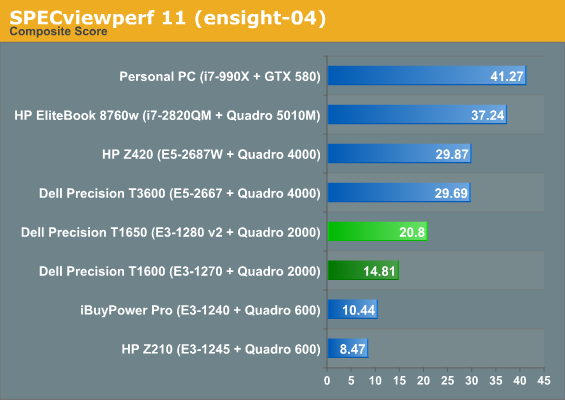
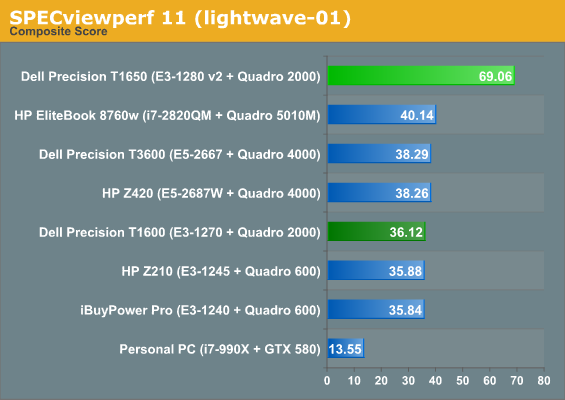

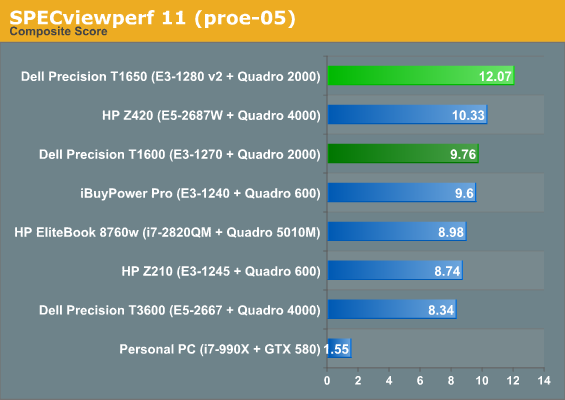
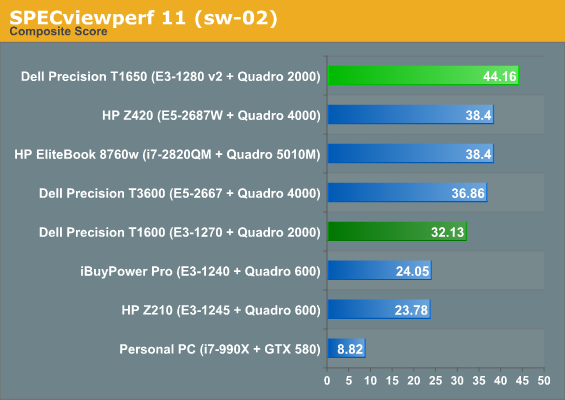
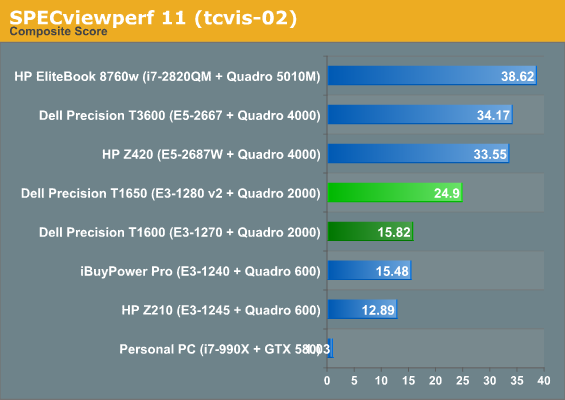
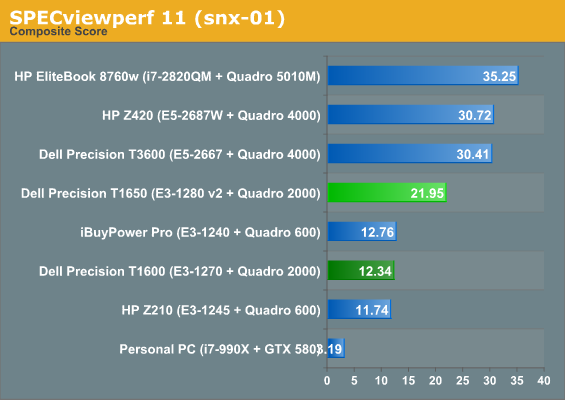
The T1650 may have had a modest boost over the T1600 in desktop applications, but jump over to SPECviewperf 11 and it's a bloodbath. There are three major differences to account for here: the T1650 has twice as much memory as the T1600 did (the T1600 had only 4GB) and that memory is running at a higher speed, the E3-1280 v2 has both higher clocks and a higher IPC, and the drivers used on the Quadro 2000 are bound to be newer. It's still difficult to figure out how the Lightwave portion, a benchmark that up until this point seemed to be moderately GPU-limited, produces a score quite so high, though.
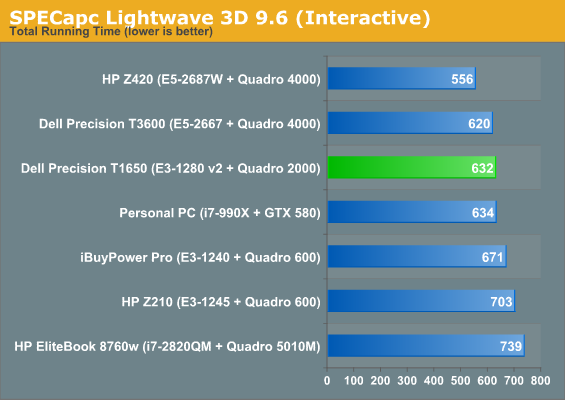
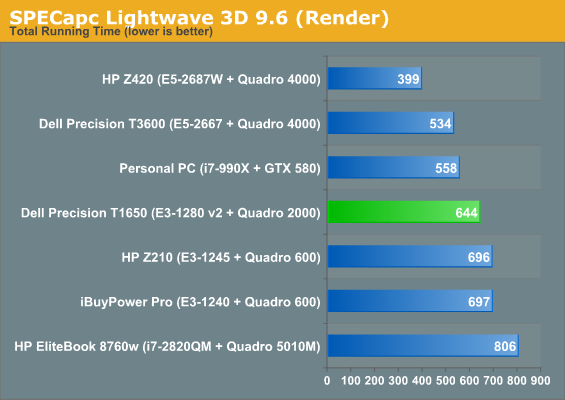

When we run the separate SPECapc Lightwave benchmark, results are a little more in line with what we expect, but it's clear the T1650's Xeon v2 is still a demon capable of meeting or beating faster hexa-core systems like the T3600.










38 Comments
View All Comments
Parhel - Tuesday, July 31, 2012 - link
Honestly, that seems like a smart route to take. I'm not a hardware guy at all, but I think it makes sense. I would worry about longevity if they were mechanical drives, but with the SSDs, that should be good for the long haul. We just lease all our stuff at my work anyways, so the costs are entirely different.Kaldor - Tuesday, July 31, 2012 - link
Leasing is an option, but generally from a financial standpoint buying your desktops and leasing your laptops is the best route. When you lease, you cannot depreciate the hardware yearly. Thats also the reason we run on a 5 year cycle. Write off 20% per year. Cant do that leasing!We do lease our laptops, and thats purely from a wear and tear standpoint. Every 3 years we turn them around. But we have far less laptops than desktops.
The SSD vs HD will always be a debate. I dont feel that a spinning HD dying is a major issue myself. I expect to replace 20% of the drives within the lifecycle of a desktop. Thats why we have networks drives and images. The SSDs are not there to provide durability, but to make the user experience better. I was once asked how we could improve the user experience 4-5 years ago, and I gave them two things, make sure the computer has twice the RAM in it that is really needed, and use an SSD for your application drive. All the rest falls into place after that.
Ananke - Tuesday, July 31, 2012 - link
These are like two dozen people at Apple, a dozen at Oracle and Google, etc. .. you get the idea. They don't use desktop workstations anyway, a good laptop - most likely MacbookPro is enough.Similar workstations are in use for CAD.
Parhel - Tuesday, July 31, 2012 - link
What, the salary? Maybe that was on the high side, but it's not all that unrealistic for a senior level DBA / software architect type job. At my organization, everyone in our development team automatically gets both a desktop workstation and a mobile workstation, from the most entry level guy on up. Even the QA team. And the higher levels guys basically get whatever they ask for. Why be cheap with the tools you give your top talent?Penti - Wednesday, August 1, 2012 - link
An engineer would need options that just isn't available on the cheapest desktops to begin with. Plus a decent business notebook (not workstation-class) is already 1500-2000 at base value, add in screens and keyboards etc. It's all in all nothing when it comes to the software cost. A Visual Studio seat with Team foundation plus licenses for testing stuff would cost you more then this workstation. Hardware engineers would use much more expensive software will need specialized hardware, add-on cards and so on too. A 5000 dollar workstation is nothing if it allows you to do your job. You might get by on older hardware and software, but you would suffer other limitations from doing that.Any way managing your licenses will earn you more saving then skimping on your technical staff and engineers. It's not the office worker, sales staff, warehouse staff and janitors that will sit on workstations. They will have cheap desktops or more expensive business notebooks, depends on how everything is run. Hardware costs aren't a problem when just paying your basic software licenses (Windows, Office etc) will cost you more then a cheap desktop machine. The cheapest machines won't be as manageable and more expensive to serve then stuff made for business too. It's not cost of hardware that is a factor here. It's it environment, service/setup and use. Everybody probably shouldn't use the same machine. Some will cost more.
tipoo - Tuesday, July 31, 2012 - link
Lol...Who said it was for office workers typing in Office? Not every machine is for everyone.miebster - Tuesday, July 31, 2012 - link
Am I missing something?What is the point of a computer like this? From dell you can get an optiplex 990 core i5 2500k, 16 gb ram, and 120gb ssd for $1200. Can someone give me a reason to buy the workstation over the optiplex?
Parhel - Tuesday, July 31, 2012 - link
Compare the prices without all the options, and it doesn't look so bad. The CPU upgrade alone is $1100 over the base price. The GPU is $600. There are specific cases where you might opt for a workstation over a desktop, but the prices you're talking about aren't representative. The options on this review model seem to more to "show off" rather than represent a realistic configuration.HammerStrike - Tuesday, July 31, 2012 - link
Workstations are designed for users who have high performance computing needs ( CAD/CAM, engineering, financial modeling, scientific apps, etc. ) Main difference is:1. Processors that have more cache on chip (hence the Xeon's). Higher end models alls offer multi-processor support as well.
2. Beefer motherboard to support Xeon processors - basically server MB's.
3. Pro grade graphics cards. Main difference here is that they have driver support and are optimized for applications mentioned above. Most of those apps won't really run on a consumer card, and even if you could get them going you wouldn't get any support.
Higher end work stations will typically support additional memory/types (standard business PC's typically top out around 16GB, while you can get a workstation with 64GB+ of ECC memory), as well as additional storage options (RAID 5, 10, etc, sometimes additional backup options, such as tape drive).
Admittedly, they probably sell 100 standard business boxes for every workstation, but if you are running a program that needs one you, well, need one. As mentioned above, much of the software that a workstation is designed for wouldn't run on anything else (no driver support), but for the apps that do offer more cross "platform" support the performance boast boast is night and day. It can be the difference of jobs taking minutes vs hours to complete.
As far as the Dell Precision units are concerned, they also offer some builds that are pre-certified to be compatible with many "workstation" grade applications and perform at a certain level with them. If you have an issue on a workstation that is pre-certified Dells support team will be able to troubleshoot and assist both the hardware and software issue. Depending on the issue, they may need to bring in the software developer, but the Dell team works with them tdirectly. Many companies find a lot of value in that.
alxxx - Wednesday, August 1, 2012 - link
plus space for a full length pcie card/sMore than 1 pcie x16 gen 3 slot (if needed)
E5 is the only Intel chip so far to have DDIO.
Expect to see it in all of them eventually.
A better comparison would have been with hp z420-E5-1620.
The one here seems a lot quieter than the z400.